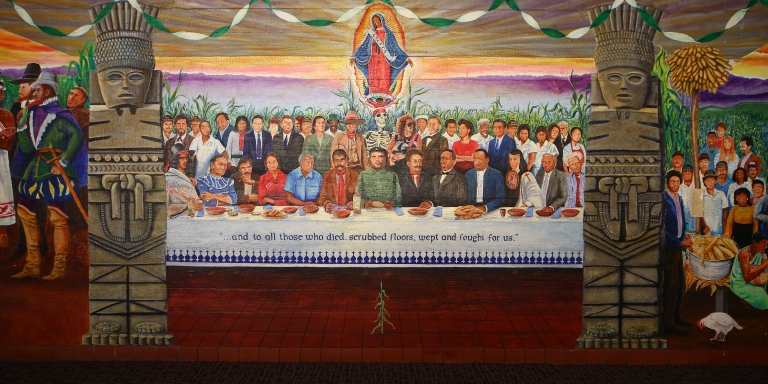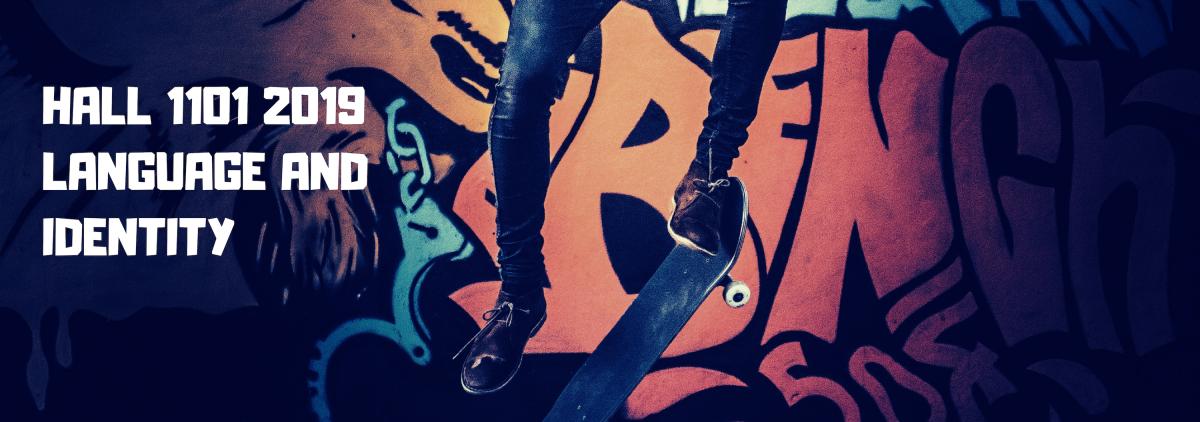What It Means To Be Chicano/Chicana

The Last Supper of Chicano Heroes
The painting is a re-construction of Leonardo da Vinci’s painting “The Last Supper”. The Last Supper is the final meal that Jesus shared with his 12 apostles in Jerusalem before his crucifixion.
Artist Burciago stated that his intentions were, “To portray the 12 Apostles dining on tortillas, tamales and tequila instead of bread and wine” ( 1988). The typical Mexican food that we already know of. But for those that don’t know, tortillas are made with water based dough which is pressed then cooked. Tamales are made of dough, which is steamed in a corn husk or banana leaf. They also vary from spicy to sweet but if you want to be basic you can have the plain ones that are made with just cheese. Tamales are typically made only on special occasions, whether it be a birthday party or a holiday but tamales never miss out on any family gathering . He decided to also replace the religious figures with 13 Chicano heroes when he was persuaded by students to mix humor with religion.
The creator, Jose Antonio Burciago, had also polled a total of 200 Chicanos students and activists from the late 1960s to find out whom they considered the top 13 Chicano heroes . But not all the heroes had to be Chicano. In the painting the important historical figures included was Mexican general and politician Ignacio Zaragoza, legendary bandit who became a hero Joaquin Murrieta, American labor leader and civil rights activist Cesar Chavez along with Dolores Huerta, the father of Chicano theater Luis Valdez, La Virgen de Guadalupe, revolutionary Che Guevara, Mexican artist Frida Kahlo, poet Sor Juana Inez de la Cruz, Dr. Martin Luther King Jr., a leading figure in the Mexican Revolution Emiliano Zapata, Mexican American guitarist Carlos Santana and Death-La Muerte received enough votes to stand behind the lucky 13.
The 200 people that were questioned took important parts in Burciaga’s tribute “and to all those who died, scrubbed floors, wept, and fought for us” the reason for why I choose this picture. The quote pays respect to those that contributed to the Chicano history so that we would be able to have an identity and to those that brought about change to our society during that time. So that students could be encouraged to be biliterate, helping schools to promote bilingualism by providing medals and seals which is known as The New York State Seal of Biliteracy. It was signed into law by Governor Cuomo on July 31, 2012 and was introduced into my high school just last year. It’s important to realize that what we know as history is relevant to our life right now and helps us understand our society today .

Cinco de Mayo
An important date that allow us as Chicanos and overall the latino community feel connected to our ancestors and represents the mixture of Mexican American culture is May 5th. Every year a Cinco de Mayo Parade takes place around Sunset Park which is located in Brooklyn or in Manhatten. The city is flooded with Mexican pride. That day I could walk out in green, white and red and not be the only one. According to Ph.D writer Felipe de Ortego y Gasca, “Cinco de Mayo is regarded by most Mexican Americans (Chicanos) as a day of commemoration symbolizing the strength of the human spirit in the face of overwhelming adversity”(2011). Cinco de Mayo is the day that commemorates a victorious battle that took place in Puebla, Mexico. Known as “La Batalla de Puebla” and not the Independence Day of Mexico . The celebration of Cinco de Mayo became among Mexican immigrants a way of encouraging pride in their Mexican heritage in the United States. Serving as a reminder that we are powerful despite the discrimination we face. That Cinco de Mayo is the day that represents unity. To be able to celebrate our pride, remember our roots, honor our traditions and remember where we came from along with our community. Therefore we shouldn’t be ashamed but rather proud of our backgrounds. As Chicanos we protect immigrants and Dreamers and we can fight against discrimination and racism not in a form of violence but rather showing that we can become doctors or lawyers and make a difference in society while remembering and honoring our ancestors.
 Our Lady of Guadalupe Our Lady of Guadalupe, also known as the Virgin of Guadalupe, is an iconic symbol of Mexican Culture. She is depicted with brown skin, an angel and moon at her feet and rays of sunlight that encircle her. Her image was used as religious figure like god is used but during the Chicano Movement it was used for equality in the United States and as a visual representation of the fight for independence in Mexico, the farm workers struggle in the 1960s and as a symbol of justice. According to Raul A. Reyes an attorney and member of the USA Today Board of Contributors stated, “To the present day, Our Lady of Guadalupe remains a powerful symbol of Mexican identity and faith, and her image is associated with everything from motherhood to feminism to social justice”(2016). As a Chicana, it is our duty to keep our traditions alive and continue to support them. To me she is not only the mother of all men and women but she is a sign of hope and more than just a saint. Every year during the night of Dec. 11 on the vigil of her feast thousands of faithful come to the shrine to sing to the Virgin all over the world. On December,11 my family goes every year to The Church of Our Lady of Guadalupe and St. Bernard located in Manhattan, where many gather and wait on line to enter the church for a short mass where we honor and thank her for our family, health, the many blessings, and for being our hope in difficult situations. As I grow order she is one of the many beliefs I will carry throughout my life because she is important not only to me but to my community.
Our Lady of Guadalupe Our Lady of Guadalupe, also known as the Virgin of Guadalupe, is an iconic symbol of Mexican Culture. She is depicted with brown skin, an angel and moon at her feet and rays of sunlight that encircle her. Her image was used as religious figure like god is used but during the Chicano Movement it was used for equality in the United States and as a visual representation of the fight for independence in Mexico, the farm workers struggle in the 1960s and as a symbol of justice. According to Raul A. Reyes an attorney and member of the USA Today Board of Contributors stated, “To the present day, Our Lady of Guadalupe remains a powerful symbol of Mexican identity and faith, and her image is associated with everything from motherhood to feminism to social justice”(2016). As a Chicana, it is our duty to keep our traditions alive and continue to support them. To me she is not only the mother of all men and women but she is a sign of hope and more than just a saint. Every year during the night of Dec. 11 on the vigil of her feast thousands of faithful come to the shrine to sing to the Virgin all over the world. On December,11 my family goes every year to The Church of Our Lady of Guadalupe and St. Bernard located in Manhattan, where many gather and wait on line to enter the church for a short mass where we honor and thank her for our family, health, the many blessings, and for being our hope in difficult situations. As I grow order she is one of the many beliefs I will carry throughout my life because she is important not only to me but to my community.
Works Cited
- “Why Chicanos Celebrate Cinco De Mayo.” Somos En Escrito
- “Our Lady of Guadalupe Is a Powerful Symbol of Mexican Identity.” NBCNews.com, NBCUniversal News Group
- Burciaga, Jose Antonio. “Cinco De Mayo–Some Uncommon Heroes for a Day Commemorating Heroism.” Los Angeles Times, Los Angeles Times, 5 May 1988



